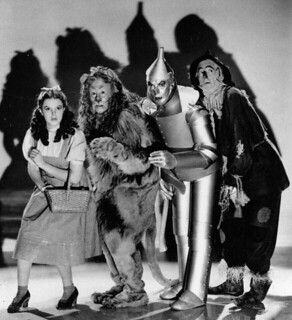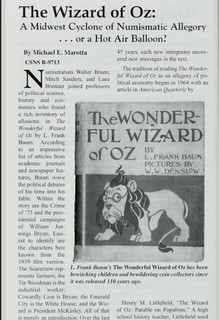
PREV ARTICLE
NEXT ARTICLE
FULL ISSUE
PREV FULL ISSUE
THE SYMBOLISM BEHIND THE 'WIZARD OF OZ'Retired University of Florida economics professor Dave Denslow published an article December 21, 2016 in the Gainesville Sun on the symbolism behind the 'Wizard of
Oz'. See the links below for earlier E-Sylum articles on the topic. -Editor
Seeing their incomes erode and their land foreclosed, farmers joined the Populist movement, thrilled by William Jennings Bryan's "Cross of Gold" speech at the Democratic National Convention in Chicago in 1896 - "you shall not crucify mankind upon a cross of gold" - calling for silver coinage to boost prices and thus relieve the burden of farmers' debt. Parents reading Frank Baum's 1900 American fairy tale "The Wonderful Wizard of Oz" to their children readily understood his social satire. They read the "Wizard," the best-selling Christmas book of the year, as both fairy tale and parody, not as a coherent parable of Populism but more in the spirit of opportunistic mocking by Will Rogers or Gilbert and Sullivan, or today by Saturday Night Live or Capitol Steps. Baum himself was a Republican, not a Populist, though his satirical writings took on all alike, even his admired suffragists, when he edited a newspaper in Aberdeen. After gaining fame from "The Wonderful Wizard of Oz," he would travel to a city to present two speeches, the first to Republicans deriding Democrats and the second the reverse. As to the book, the Scarecrow without a brain stands for farmers and the Tin Woodman without a heart for dehumanized industrial workers. The Woodman had rusted into inactivity, the way factory workers were unemployed during the recession As railroads and large ships opened new expanses to agriculture and use of farm machinery diffused, prices of farm products fell. Hastening their decline was the Coinage Act of 1873, which eliminated the coinage of the silver dollar and became known as the Crime of '73. Removing silver from circulation reduced the quantity of money and thus prices, adding to the burden of debt shouldered by farmers and small businesses and shifting wealth to the eastern bankers. A bushel of wheat brought only half as much in 1898 as in 1873. Sugar and cotton prices fell even more. v Seeing their incomes erode and their land foreclosed, farmers joined the Populist movement, thrilled by William Jennings Bryan's "Cross of Gold" speech at the Democratic National Convention in Chicago in 1896 - "you shall not crucify mankind upon a cross of gold" - calling for silver coinage to boost prices and thus relieve the burden of farmers' debt. Parents reading Frank Baum's 1900 American fairy tale "The Wonderful Wizard of Oz" to their children readily understood his social satire. They read the "Wizard," the best-selling Christmas book of the year, as both fairy tale and parody, not as a coherent parable of Populism but more in the spirit of opportunistic mocking by Will Rogers or Gilbert and Sullivan, or today by Saturday Night Live or Capitol Steps. Baum himself was a Republican, not a Populist, though his satirical writings took on all alike, even his admired suffragists, when he edited a newspaper in Aberdeen. After gaining fame from "The Wonderful Wizard of Oz," he would travel to a city to present two speeches, the first to Republicans deriding Democrats and the second the reverse. As to the book, the Scarecrow without a brain stands for farmers and the Tin Woodman without a heart for dehumanized industrial workers. The Woodman had rusted into inactivity, the way factory workers were unemployed during the recession. The Wizard may portray President William McKinley, according to historian Samuel Eliot Morison "a kindly soul in a spineless body", no more competent than any ordinary person and powerful only because his subjects agree to obey him. The Wizard's name Oz could be the abbreviation for an ounce of gold, the letters O to Z on the second of Baum's pair of filing cabinets, or just a word that sounds good with Wizard. In any case, the story has allusions to Bryan's campaign to add silver coinage to the gold standard. These include the yellow brick road, the silver slippers (changed to ruby in the 1939 MGM movie starring Judy Garland and Bert Lahr), and even the seven passages and three flights of stairs, recalling the Crime of '73, through which Dorothy is led to her room in the palace. It is a tribute to the steadfast nature of human folly that much of Baum's tale parodies events today. But you can simply read it to your children, enjoy the abundant original illustrations, and dream that all of us can discover brains, kindness, and courage within ourselves. To read the complete article, see: To read the earlier E-Sylum articles, see: I checked with Mike Marotta about his article, and it was published by the Central States Numismatic Society in The Centinel, Vol. 58, no. 2, Summer 2010, p. 58-61. The title
is The Wizard of Oz: Child’s Tale or Numismatic Allegory. Here's a link to the issue on the Newman Numismatic Portal: https://nnp.wustl.edu/library/book/513708 . Below are other references Mike shared. Thanks! -Editor
I posted the bibliography on Rec.Collecting.Coins and it was copied by other people to other forums (fora), as for instance: Apparently, I uploaded the Centinel article to Scribd: More recently (2014), I put the discussion up on ObjectivistLiving: I do not seem to have anything posted to the ANA Blogs. Finally, it is a funny thing, but I have a blog, NecessaryFact.blogspot.com, and I write for myself mostly on whatever interests me. Other people do read it apparently. The most popular article
(3630 page views total since 2011; 45 of the 59 views all week; and 4 for today right now) remains "What (if anything) Did Dorothy Learn?"  Wayne Homren, Editor The Numismatic Bibliomania Society is a non-profit organization promoting numismatic literature. See our web site at coinbooks.org. To submit items for publication in The E-Sylum, write to the Editor at this address: whomren@gmail.com To subscribe go to: https://my.binhost.com/lists/listinfo/esylum All Rights Reserved. NBS Home Page Contact the NBS webmaster 
|

